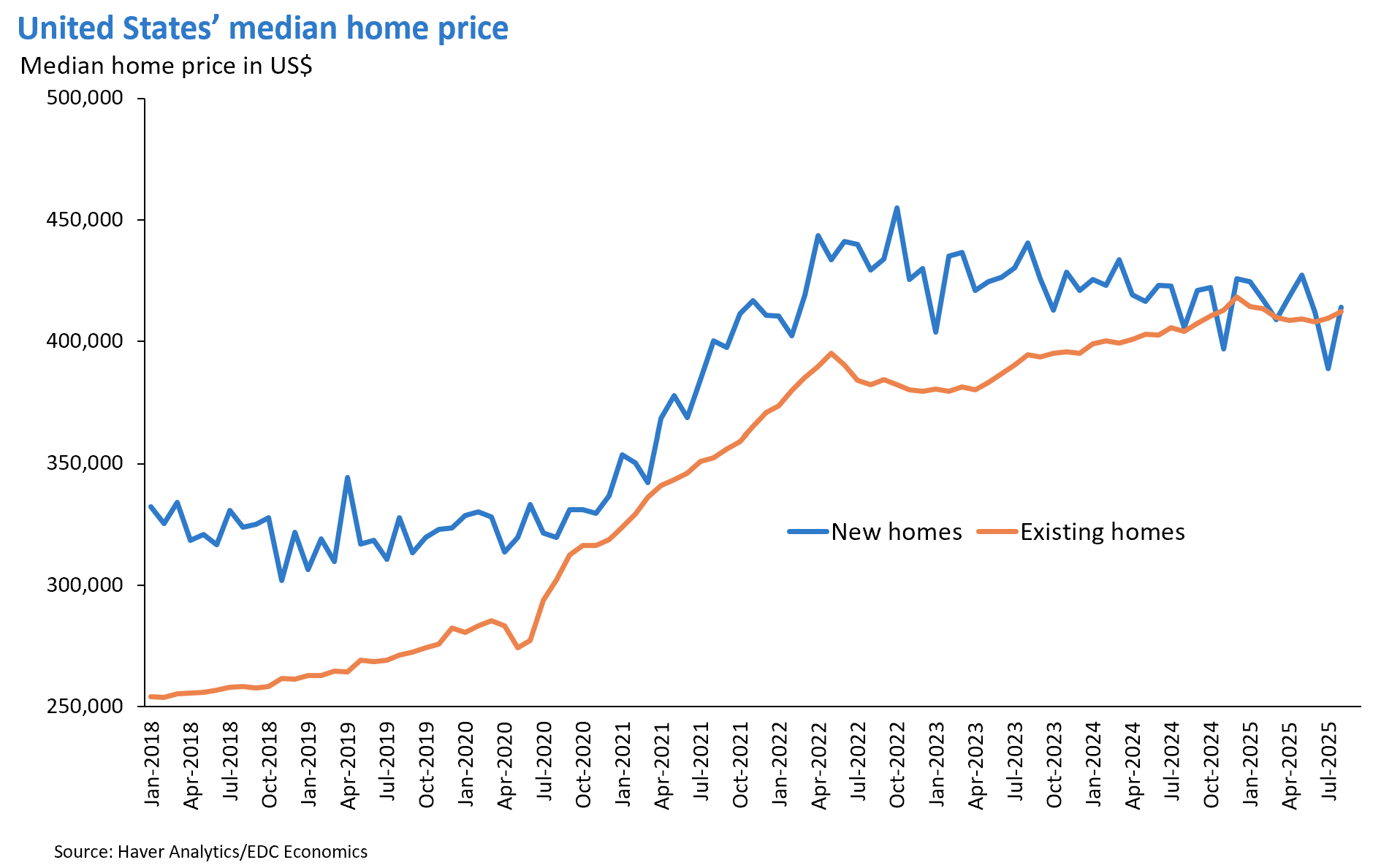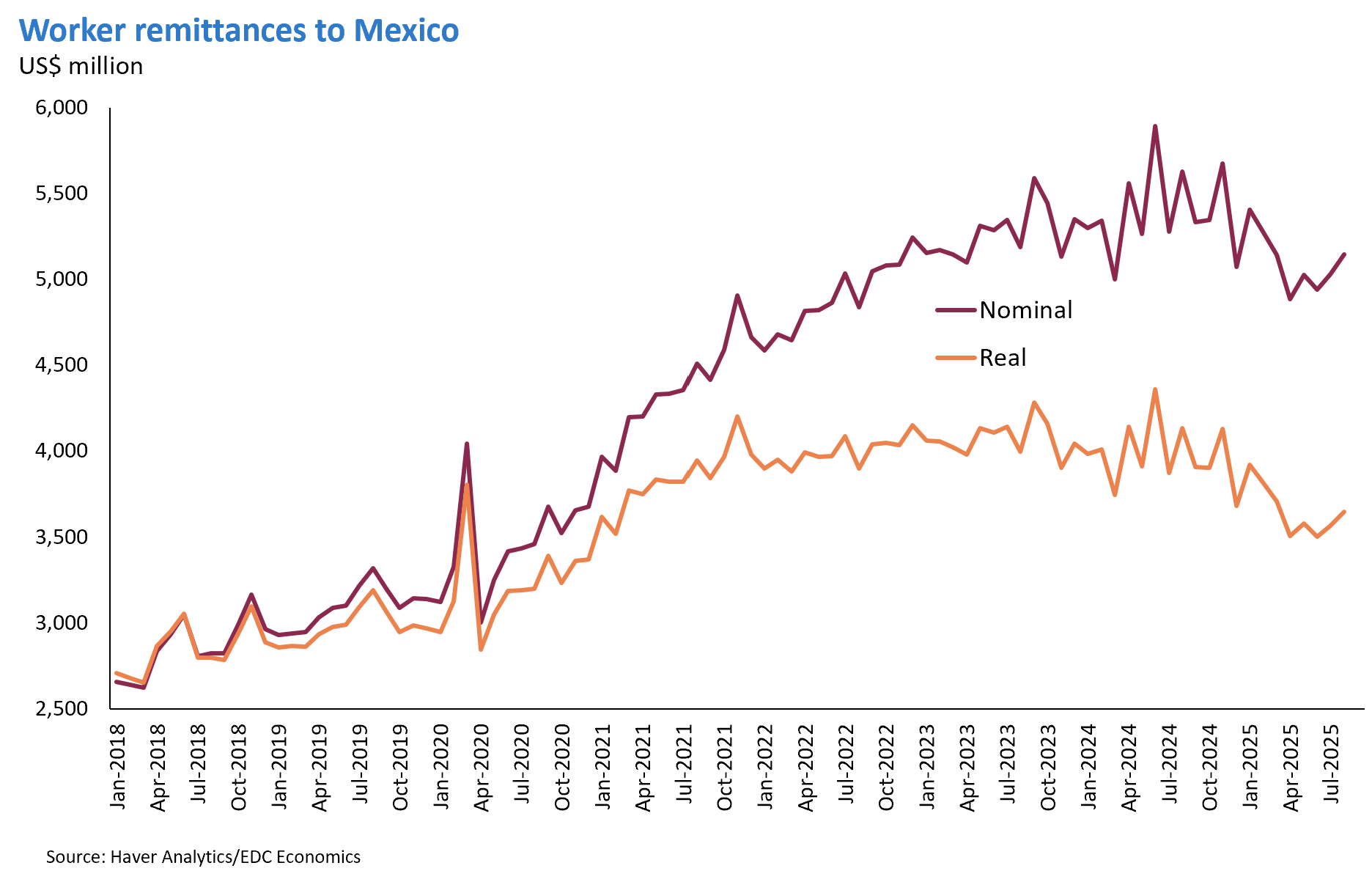Wait! Don’t go!

You’re in!
Your request has been submitted. Keep an eye on your inbox; EDC’s trade intelligence is coming your way.
Are you missing out?

You’re in!
Your request has been submitted. Keep an eye on your inbox; EDC’s trade intelligence is coming your way.
Tariffs imposed by the United States and China are significantly impacting economic growth across North America. The result: Slower production, hiring and investment, alongside muted inflation and uncertain business outlook for 2026.
Trade friction continues to grind down economic activity across the continent as production and hiring decrease. Although trade and economic policy uncertainties have eased, they remain elevated by historical standards. The upcoming review of the Canada-United States-Mexico Agreement (CUSMA) is influencing business decisions, while the U.S. government shutdown adds a new layer of uncertainty to the world’s largest economy.
Inflation has moderated across North America, with businesses largely absorbing tariff-related costs. However, their ability to pass these expenses on to consumers will be tested as profit margins tighten and the holiday shopping season approaches.
With inflation under control and labour markets showing signs of fragility, central banks across North America are lowering policy rates to stimulate demand. Yet, elevated housing prices are likely to blunt the impact of lower mortgage rates. Additionally, reduced immigration in the United States and Canada—due to stricter entry requirements—is expected to further dampen demand.
Explore the Global Economic Outlook 2025
Get EDC’s latest insights on inflation, trade and growth across North America.
You should also check out
With growing risks, Canadian companies face new challenges. EDC’s Global Economic Outlook offers insights to help you make better business decisions.
The U.S. labour market is cooling, with job gains slowing and wage growth flattening. Moderating inflation allowed the Federal Reserve to resume its rate-easing cycle in September. Additional rate cuts are expected before year-end to support weak domestic demand.
Economic activity has softened across several sectors. Lower-income households are struggling to stay afloat, curbing consumer spending. Confidence among consumers and businesses remains low. Non-farm payrolls averaged just 75,000 per month from January to August—nearly half the pace of the same period last year. Wage growth has also slowed, pointing to weaker consumer spending ahead.
Housing affordability remains a major challenge. Elevated mortgage rates and high construction costs—exacerbated by tariffs on Canadian lumber—have pushed new home construction to its lowest level in five years.
Countervailing and anti-dumping duties, along with national security-based tariffs, have raised duties on Canadian lumber to 45%, adding more than US$9,000 to the average U.S. home price and has stifled new builds.
Compared to pre-pandemic levels, the median home price for August was 28% higher for new builds and 46% higher for the resale market. Immigration crackdowns are depriving the construction and agriculture sectors of skilled workers, further disrupting activity.

While trade negotiations with China, India, the European Union (EU) and United Kingdom (U.K.) have provided more specifics on the tariffs facing trade with those countries, the 2026 review of CUSMA is expected to significantly influence business confidence and investment decisions. Although the implementation of tariffs as of August has slowed and will continue to limit U.S. economic momentum, a recession is unlikely in EDC Economics’ assessment.
Real gross domestic product (GDP) is forecast to slow to 1.4% in the second half of 2025—down from 2% in the first half—with full-year growth averaging 1.7%. That pace is expected to hold steady in 2026 as well, as tariffs continue to shape the economy. For additional Export Development Canada (EDC) insights and analysis on the business environment of the U.S. visit U.S. market intelligence | EDC.
Canada’s economy is under pressure from tariffs imposed by two of Canada’s largest trading partners. The United States has levied global sector-specific tariffs on steel, aluminum and copper products, motor vehicles, heavy truck and parts and hiked existing tariffs on lumber. At the end of August, the U.S. also ended the de minimis shipping exception for goods under $800. Canadian exports that are non-compliant with CUSMA face a 10% tariff on energy and potash, and a 35% tariff on all other non-compliant goods. These measures present a significant challenge for Canadian exporters.
China also imposed steep tariffs earlier in 2025: 75.8% anti-dumping duties on Canadian canola seed, a 100% tariff on canola oil, meal and peas, and a 25% tariff on seafood and pork. These actions have had an impact, with Canadian export volumes to China falling 11% in July compared to January.
Canada has removed nearly all tariffs on U.S. imports, except for a 25% tariff on autos, steel and aluminum. This move supports Canada’s inflationary outlook, which remains muted. With pricing pressures subdued, the Bank of Canada is expected to implement further rate cuts before year-end to support the economic outlook.
The unpredictability of tariff and trade policy has created uncertainty for businesses, eroding both consumer and investor confiencde. This has led to delayed investments, operational caution and job losses. The unemployment rate rose to 7.1% in September—the highest since October 2021—and further layoffs could deepen the strain on Canadian households.

Tariff tensions have also affected currency markets and the overall global economy. Investors have moved away from the U.S. dollar, leading the Canadian dollar to increase to US$0.72 by early October, from US$0.69 in January. Negative sentiment toward U.S. tariffs is likely to persist into next year, helping to strengthen the loonie further, potentially reaching US$0.73 by the end of 2026.
Mexico’s economy is contending with policy constraints and external pressures that are slowing growth. Job prospects remain limited and undocumented Mexican immigrants in the United States face rising deportation risks. Many are staying indoors to avoid detection, cutting off a vital source of remittance income. Remittances were down 5.6% year-to-date in August.

Government spending commitments have left little fiscal room for infrastructure investment. The proposed 2026 budget falls short of the International Monetary Fund’s (IMF) recommended deficit-to-GDP ratio, limiting the government’s ability to stimulate economic activity.
Uncertainty persists following reforms that may weaken Mexico’s institutional and governance frameworks—key factors in attracting foreign direct investment (FDI). Some previously announced FDI has been cancelled or delayed, and the inflow remains modest compared to Mexico’s reshoring potential.
U.S. tariffs are discouraging companies from establishing operations in Mexico. For example, Honda shifted its planned Civic Hybrid production from Mexico to Indiana, citing the 15% tariff on autos and parts and the 50% tariff on steel and aluminum entering the United States. With more than 80% of Mexico’s exports destined for the U.S., maintaining open access to that market is critical. The Mexican government will be hoping the CUSMA review process helps restore trade certainty.
Inflation remains within the Bank of Mexico’s (Banxico) target range, allowing for continued rate easing. The peso is expected to depreciate by 5.4% next year, averaging MX$20.86, following an expected 8% decline this year to MX$19.78. Overall, Mexico’s economy is expected to grow by 0.9% in 2025 and 1.3% in 2026.
Read EDC’s Global Economic Outlook for additional insights on how tariffs and trade tensions are shaping Mexico’s economy and the broader North American landscape.
How EDC can help Canadian exporters
For more on how current trade uncertainty presents opportunities for deeper economic integration between Canada and Mexico, visit EDC’s Trade Matters column. As North American economies navigate the ongoing challenges of global trade tensions, tariff uncertainty and shifting policy landscapes, businesses must remain agile and informed. With targeted support programs and expert guidance, EDC stands ready to help Canadian exporters adapt, compete and grow in a complex international environment.
EDC offers a range of solutions to support Canadian companies in their global expansion—from market intelligence to strategic business connections. Our sector-focused teams bring deep expertise and local knowledge to help exporters navigate international markets.
On March 7, the Government of Canada announced $6.5 billion in support for businesses impacted by ongoing trade uncertainty. This includes the launch of EDC’s Trade Impact Program (TIP), which will facilitate an additional $5 billion over two years in support for eligible companies.
“We have local knowledge of how to do business in different markets, but we also have the right people who have the connections, and we can leverage that benefit to Canadian exporters,” says Jorge Rave, EDC’s regional vice-president for Latin America and the Caribbean.
“We have a significant and strong Team Canada, including the Trade Commissioner Service, as well as our guides on local culture and doing business as a Canadian exporter,” Rave says.
Additional resources
- To learn more, check out our U.S. market intelligence page for insights on how to navigate the U.S. business environment.
- EDC’s Export Help Hub: Connect with EDC trade advisors for guidance on market strategies, regulations and customs.
- EDC offers the Business Connections Program, which promotes Canadian export capabilities to international buyers.
- For Canadian exporters who need to mitigate risk, EDC offers financial and risk management solutions and tools, including the Country Risk Quarterly.
New to EDC? Take a quick assessment to see how we can support your business.
Already an EDC customer? Stay informed on the current U.S. business environment and Canada-U.S. trade issues by contacting your EDC relationship manager or calling 1-800-229-0575.





